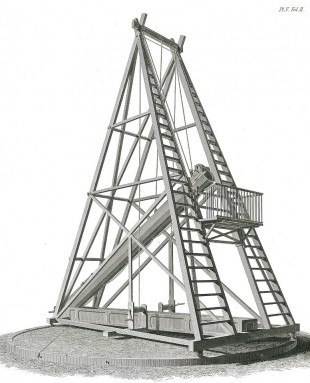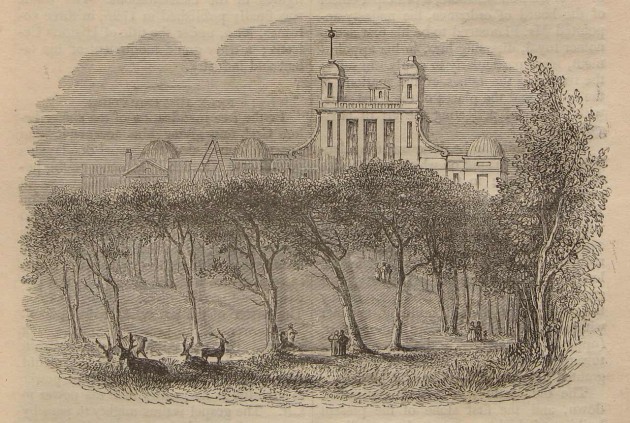…where east meets west
- Home
- Brief History
- The Greenwich Meridian
- Greenwich
(1675–1958) - Herstmonceux
(1948–1990) - Cambridge
(1990–1998) - Outstations (1822–1971)…
- – Chingford (1822–1924)
- – Deal
(1864–1927) - – Abinger
(1923–1957) - – Bristol & Bradford on Avon
(1939–1948) - – Bath
(1939–1949) - – Hartland
(1955–1967) - – Cape of Good Hope
(1959–1971)
- Administration…
- – Funding
- – Governance
- – Inventories
- – Pay
- – Regulations
- – Royal Warrants
- Contemporary Accounts
- People
- Publications
- Science
- Technology
- Telescopes
- Chronometers
- Clocks & Time
- Board of Longitude
- Libraries & Archives
- Visit
- Search
Telescope: Ramage’s 25-foot telescope (c.1820)

Ramage's 25-foot telescope. Engraving by E Turrell after T Bradley. From Memoirs of the [Royal] Astronomical Society, Volume 2 (1826)
Background to the telescope’s construction
In the early 1800s, John Ramage, a merchant from Aberdeen began constructing Herschelian like telescopes. In 1817 he constructed a telescope of 20 feet focal length, with a speculum mirror of 13½ inches in diameter and in 1820, one of 25 feet focal length, with a mirror of 15 inches. By 1825, he had made two further 25 foot telescopes with 15 inch mirrors. One of the three 25 foot telescopes was sent to Greenwich. Another was in the possession of Captain Ross, the arctic navigator, at Stranraer. One is also said to have been acquired by Dr. Dauney, a professor of Law and set up at Broadford near Aberdeen. In 1823, Ramage also made a 21 inch mirror of 54 feet focal length, which was still without a mount in 1825.
The telescope’s arrival at Greenwich
Clearly visible from the surrounding Park, the arrival of the telescope at Greenwich aroused considerable interest and was reported in several journals of the time. The extract below, describing some of its supposed merits, is from the Monthly magazine or British Register of Literature, Sciences and Belles Lettres, Volume 28, Part 2 p.201, (February 1826)
‘Mr. Ramage the optician, of Aberdeen, has arrived in town, and brought with him his large reflecting telescope, which is to be fixed in the Greenwich Observatory, where it is shortly to be exhibited to men of science. It is much smaller than the great reflecting telescope of Herchel; but its power is considerably greater. The machinery of Herchel’s telescope is extremely complicated, and requires the strength of two men to regulate its movements. All the motions in Ramage’s telescope are produced in the simplest manner, by means of a few cords; yet it is perfectly steady and free from tremor, and may he managed by the observer without an assistant, almost as easily as a three foot achromatic telescope. This is a great advantage, as the observer can place the tube in any position for vision better than any assistant. When the observer is in the gallery, he is able to keep the object a long time in view, as the telescope may sweep backwards and forwards ten degrees, and he may elevate or depress it with one hand, by means of a winch at the side. The specula’s are much clearer, finer in the polish, and more accurate in their form, than those of any other glass. Mr. Ramage has not entrusted the important part of the workmanship to others, but has executed with his own hands the more delicate portions of this admirable monument of his skill.’

The Royal Observatory from the north with Ramage's 25-foot telescope rising up from the Courtyard and the newly installed time ball on the roof of Flamsteed House. Curiously, the 1820 addition to Flamsteed House for the Great Zenith Tube has been omitted. From The Weekly Visitor, (3 Feb, 1835)
Not so good as initially thought
According to Pearson, the Greenwich telescope,
‘which at first astonished the observers, who had not been accustomed to examine a heavenly body with an instrument possessing so much light; and its performance was deemed quite extraordinary; but when the first impression had subsided, and different trials had been made in different states of the atmosphere, it was discovered that the central portion of the speculum was more perfectly figured, than the ring ordering on the extreme edges. When the aperture was limited to ten or eleven inches, the performance, as to distinctness in the definition, was greatly improved, and the light was so brilliant, that the astronomer royal was disposed to entertain an opinion, that it might equal that of a good refractor of the same dimensions. When however very small and obscure objects are to be observed, the whole light of the entire aperture may be used with advantage on favourable evenings. Much is to be imputed to the existing state of the atmosphere, as well as to the powers of the telescope, when large instruments are used of either the refracting or reflecting construction, but more particularly of the latter, when the aperture is great.’
Quite how good or bad the telescope was is difficult to judge, for although initially embraced by John Pond, his enthusiasm soon began to wane perhaps possibly because of the deficiencies of the telescope, but just as likely because of the Observatory’s increased workload as a result of obtaining a second mural circle.
Published observations
The only observations with the telescope to be published in Greenwich Observations, seem to have been of the emersion of Saturn from behind the Moon which was observed on 16 Feb 1826 and of the immersion of the second satellite of Jupiter which was observed on 26 February 1826. Click here to view these observations as originally published.
Pond also published paper on 10 March 1826 that had resulted from his observations. Titled On an Appearance hitherto unnoticed in the Nebula of Orion, it appeared in Memoirs of the [Royal] Astronomical Society, Volume 3 (1827)
A mystery 2-foot speculum
In his book An Introduction to practical astronomy (1829), William Pearson wrote:
‘It has been asserted that a fifty-feet telescope by Ramage of twenty-one inches aperture is intended to be substituted for the twenty-five feet instrument erected at Greenwich, and the speculum we know is prepared, though not yet fully tried; but whether the plan will be carried into execution at the expense of the honorable Navy Board or not, is perhaps not yet determined.’
Had such a plan existed, it was certainly put paid to by Airy’s arrival as Astronomer Royal on 1 October 1835 and Ramage’s untimely death a few weeks later on 26 December. But was their any truth in Pearson’s assertion? The Minutes of the Board of Visitors from 1860 (ADM190/4/299) suggest there may have been. They carry the following entry: ‘The 2 feet speculum belonging to Ramage's telescope has been sent to the representatives of Mr. Ramage.’ ... But what was this 2 feet speculum and when did it come to Greenwich? Was it the 21 inch speculum of the 50 foot telescope or perhaps even the 15 inch speculum from the 25 foot telescope ... or was it truly a speculum of 2 feet ... and if so, what was its focal length?
The fate of the Greenwich instrument
Exactly when the 25-foot telescope was dismantled at Greenwich is not clear. Still present in 1836, Airy clearly wanted to be rid of it. Ramage however was now dead, so couldn’t be summoned to take it away. It was probably taken down in 1836 and certainly by early 1839 as it does not appear in Elizabeth Smith’s drawing of the courtyard. Whether it was put into storage at Greenwich or sent elsewhere is uncertain. In 1840, John Campbell, 2nd Marquess of Breadalbane, and Rector of the University of Glasgow acquired two Ramage telescopes for the University’s Horselethill Observatory which was founded that year. In an account of the observatory’s erection given at the Glasgow meeting of the British Association for the Advancement of Science in August 1840 (click here to view), one is described as being of 25 foot focal length, the other as 55 feet and 23 inches in diameter. Some believe the 25-foot instrument was the one that had been at Greenwich. What is said to be a finderscope from the 25-foot telescope was presented to the Astronomer Royal, Richard Woolley, in 1967 and is now in the care of the National Maritime Museum (Object ID: AST0921).
Contemporary accounts
The two accounts below both have the same plates. They were drawn and engraved at the joint expense of the [Royal] Astronomical Society of London and Pearson. Both accounts give a full description of the telescope’s mode of construction and operation.
Mr John Ramage's description of his large reflecting telescopes. Memoirs of the [Royal] Astronomical Society, Volume 2, pp.413–418 & Plates IV & V. (1826)
An introduction to practical astronomy Volume 2 pp.79–82. Rev. W. Pearson (London, 1829). Click here to view the accompanying Plates (Plate IX & X)
Further reading
Ramage’s Obituary. From Monthly Notices of the Royal Astronomical Society, Vol. 4, p.37 (1837).
© 2014 – 2025 Graham Dolan
Except where indicated, all text and images are the copyright of Graham Dolan